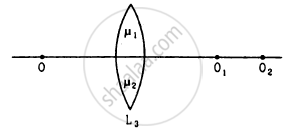Advertisements
Advertisements
प्रश्न
A combination of lenses for a camera contains two converging lenses of focal lengths 20 cm and 40 cm and a diverging lens of focal length 50 cm. Find the power and focal length of the combination.A optical instrument in which the above arrangement of convex lens is used is a convex lens used to burn paper by focusing sunlight.
उत्तर
Focal length (f1) of the 1st converging lens = 20 cm = 0.2 m
Focal length (f2) of the 2nd converging lens = 40 cm = 0.4 m
Focal length (f3) of the diverging lens = -50 cm = -0.5 m (negative sign due to sign convention)
Power = `1/"foccal length of lens (in metre)"`
Power (P1) of 1st lens = `1/0.2=2.5D`
power (P2) of 2nd lens = `1/0.4=2.5 D`
Power (P3) of diverging lens =`1/0.5 =-2D`
Net power of the combination = P1 + P2+ P3 = 5 + 2.5 + (-2) = 5.5 D
Net focal length of the combination = `1/"net power"=1/5.5=0.1818m=18.18 cm`
APPEARS IN
संबंधित प्रश्न
How unit of power related to focal length of a lens?
(a) At what distance should the lens be held from the figure in order to view the squares distinctly with the maximum possible magnifying power?
(b) What is the magnification in this case?
(c) Is the magnification equal to the magnifying power in this case? Explain.

The lens A has a focal length of 25 cm whereas another lens B has a focal length of 60 cm. Giving reason state, which lens has more power: A or B.
What is the nature of a lens having a power of + 0.5 D?
What is the nature of a lens whose power is, −4 D?
A diverging lens has a focal length of 0.10 m. The power of this lens will be:
How does focal length of a lens change when red light incident on it is replaced by violet light? Give reason for your answer.
A thin converging lens is formed with one surface convex and the other plane. Does the position of image depend on whether the convex surface or the plane surface faces the object?
Consider three converging lenses L1, L2 and L3 having identical geometrical construction. The index of refraction of L1 and L2 are \[\mu_1 \text{ and } \mu_2\] respectively. The upper half of the lens L3 has a refractive index \[\mu_1\] and the lower half has \[\mu_2\] following figure . A point object O is imaged at O1 by the lens L1 and at O2 by the lens L2placed in same position. If L3 is placed at the same place,
(a) there will be an image at O1
(b) there will be an image at O2.
(c) the only image will form somewhere between O1 and O2
(d) the only image will form away from O2.
A lens forms an upright and diminished image of an object, irrespective of its position. What kind of lens is this? Draw an outline ray diagram to show the formation of the image. State the position and one more characteristic of the image.
